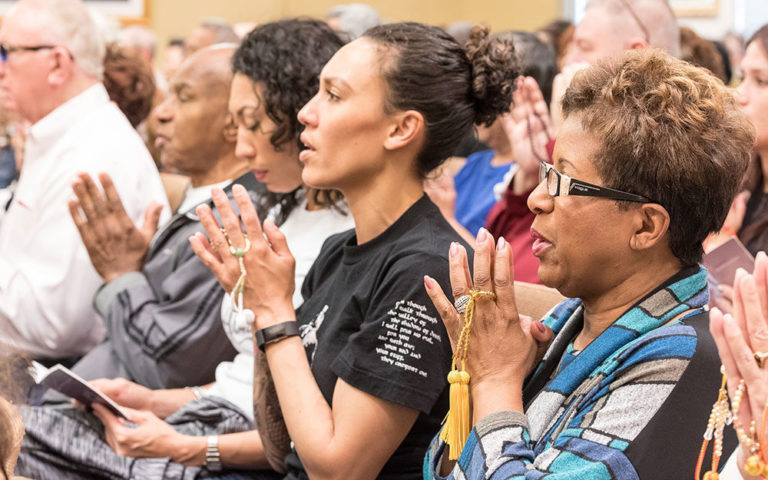Why Do Nichiren Buddhists Chant Nam-myoho-renge-kyo?

[This Q&A series addresses frequently asked questions about Nichiren Buddhism.]
Q: I used to think that Buddhists only meditate. Why do Nichiren Buddhists chant Nam-myoho-renge-kyo?
A: Nichiren Daishonin states that the practice of meditation is contained within the chanting of Nam-myoho-renge-kyo. Meditation has a long history in both the Hindu and Buddhist traditions. It was documented earliest around 1500 BCE, and was later introduced and incorporated into Buddhism during the time of the Buddha, Shakyamuni. In fact, throughout the Lotus Sutra, Shakyamuni refers to himself and others entering stages of samadhi, a practice of meditative concentration based on focusing the mind.
When Buddhism spread to China, T’ien-t’ai, who set forth a comprehensive philosophy based on the profound principles of the Lotus Sutra, developed a meditative practice called “concentration and insight.” This meditative practice, based on the principle of “three thousand realms in a single moment of life,” was developed as a method whereby people could summon from within themselves the state of Buddhahood by perceiving the true nature of their own lives.
However, Nichiren Daishonin realized that in the Latter Day of the Law, which was described in the Buddhist sutras as an age of “quarrels and disputes,” when Shakyamuni’s teachings are “obscured and lost,” silent meditation was not a sufficient practice to enable all people to fully achieve enlightenment. This is because it took a great amount of concentration and time, and people living ordinary lives amid harsh realities did not have the luxury to engage in such an effort. Even in the time of T’ien-t’ai, among those who tried to perceive the true aspect of their mind through meditation, only a few were able to achieve it.
President Ikeda points out in The Heart of the Lotus Sutra: “Even though the sutra speaks of Shakyamuni entering samadhi, this does not mean that in the Latter Day people should seclude themselves in the mountains and forests and practice sitting meditation. Nichiren Daishonin, who struggled in the very midst of society to enable all people to attain enlightenment, rejects such practices as unsuited to the time” (pp. 26–27).
Nichiren identified the “mystic truth originally inherent in all living beings” as Myoho-renge-kyo. He established the practice of chanting Nam-myoho-renge-kyo and directly manifested the Mystic Law to which he had become enlightened in the form of the Gohonzon, so that all people could awaken to the state of Buddhahood within their own lives in this defiled age of the Latter Day of the Law.
Nichiren clarifies this, saying: “The fact is that the meditation on the three thousand realms in a single moment . . . [is] contained within the five characters Myoho-renge-kyo. And these five characters, Myoho-renge-kyo, are also contained within the single life of each of us” (“The Doctrine of the Three Thousand Realms,” The Writings of Nichiren Daishonin, vol. 2, p. 85). In other words, the practice and benefits of the deepest kind of meditation are all encompassed within the chanting of Nam-myoho-renge-kyo.
Essentially, chanting Nam-myoho-renge-kyo is the most complete Buddhist practice, enabling all people today to awaken to their Buddha nature, the true aspect of their life. By expressing the essence of the Lotus Sutra as Nam-myoho-renge-kyo, Nichiren was able to establish a way for all people to achieve enlightenment, or absolute happiness.
July 2017 Living Buddhism
Nice post dear upvoted @contact95 visit my wall when you free thanks alot have a nice day :)
Thank you Shahzaibniaxi !